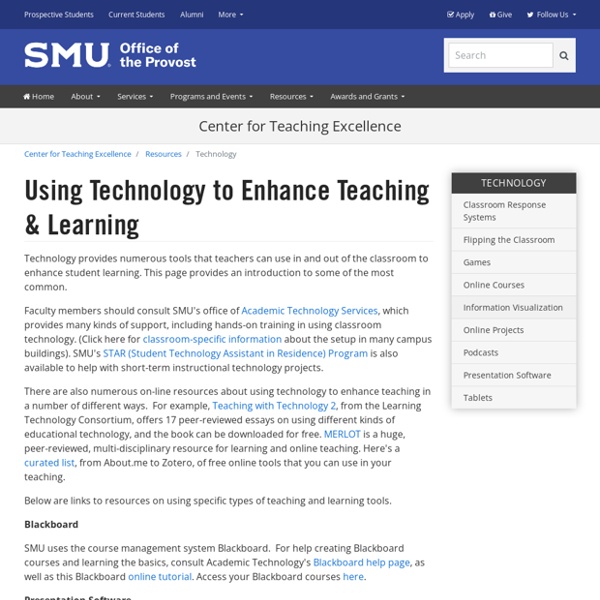



https://www.smu.edu/Provost/CTE/Resources/Technology
Related: Educational Technology10 Ways to Use Technology in the Classroom You’ve probably heard a lot about the game-changing potential of using educational technology to enhance student learning — but what are some specific examples of how teachers are utilizing new types of technology in the classroom? To find out, let’s use some technology that everyone is familiar with — the internet — to take a virtual peek at some of the top educational technology tools for teachers and tips on how to use them. Educational Technology [High-Tech Tools for the Classroom] Google Classroom — A free web service used by an estimated 30 million teachers and students, Google Classroom is designed to help teachers more efficiently create, distribute and grade assignments, boost collaboration, offer instant feedback and foster seamless communication, all in an easy-to-use, paperless format.Celestia — Do any of today’s students still dream of growing up to become astronauts?
Education Technology Tools for Teachers Massive Open Online Courses make it possible for students of all ages to access high-quality coursework at no cost. Colleges and universities across the country publish video lectures, podcasts, reading lists, practice exams and more for anyone who wants to learn about a particular subject and/or experience what it’s like to take a college class. Over the last decade, organizations such as Coursera and Khan Academy have taken MOOCs one step further by creating or aggregating thousands of free courses in areas ranging from early American history and civics to trigonometry and multivariable calculus. Khan Academy is a non-profit educational website created by educator Salman Khan in 2006. Khan, a graduate of MIT and Harvard Business School wanted to provide a free world-class education for anyone anywhere.
How to Integrate Technology Below you will find a quick overview with suggestions of what kinds of tools and activities are best matched with various levels of technology access. All of the resources linked to are either free or offer free versions. If your class has an interactive whiteboard and projector: Try interactive websites such as BrainPOP. Teaching with Technology Here is the original citation for this publication: Hooper, S., & Rieber, L. P. (1995). Teaching with technology. In A. C. 7 examples of innovative educational technology I tend to have a love-hate relationship with technology. On one hand, I enjoy the old-school pencil and paper, face-to-face communication, and less screen-related interaction. On the other hand, there are plenty of forms of technology I enjoy, rely upon, and find extremely convenient. I have the same hesitancy with new technology in education. Rather than embrace every new trend wholeheartedly without question, as a teacher and parent, I approach things more cautiously.
10 Major Technology Trends in Education Research | Spotlight 10 Major Technology Trends in Education We have a first look at the results from the latest Speak Up survey, which polled hundreds of thousands of teachers, students, administrators, parents and community members about technology trends in education. By Chris Riedel02/03/14 (2) New Messages! Recent research states that the use of technology in education has improved student’s academic performance drastically. Though traditional classroom teaching may still be prevalent, many educational instituitions are coming forward in embracing technologies. For instance, they use digital whiteboards, flipped classrooms and Chromebooks replacing textbooks. And who best to support this movement than teachers themselves? Here is a list of 8 innovative technology in education ideas to use in the classroom that is transforming the world of education: 1.
10 of the Most Engaging Uses of Instructional Technology (with Dozens of Resources and Tools) Are you looking for ways to integration technology in your lesson plans and courses that provide for an engaging experience for you and your students? Fans of instructional technology know that it can be fun and inviting, and engaged students are far more likely to be learning. I believe that if you can get students involved and motivated effectively enough, you can improve their learning habits over the long term. With that in mind, here are 10 highly engaging uses of technology in the classroom, along with dozens of tools and resources for implementation. Most of these involve free web based tools, so that's an added bonus!
How to Use Education Technology - The Ultimate Guide In his popular book, Ditch That Textbook, Matt Miller argues that the textbook is a relic from the days when teachers were the keepers of knowledge to be delivered to students in healthy doses of lectures and notes. The fact of the matter is that in today’s digital world, educators are no longer the gatekeepers of information, and students know it. Instead, the role of the educator should be to guide students as they navigate the wealth of information available at their fingertips. Use of Technology in Teaching and Learning Technology ushers in fundamental structural changes that can be integral to achieving significant improvements in productivity. Used to support both teaching and learning, technology infuses classrooms with digital learning tools, such as computers and hand held devices; expands course offerings, experiences, and learning materials; supports learning 24 hours a day, 7 days a week; builds 21st century skills; increases student engagement and motivation; and accelerates learning. Technology also has the power to transform teaching by ushering in a new model of connected teaching.